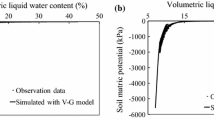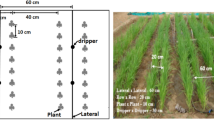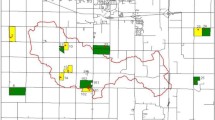Summary
A model was developed to account for the time-dependent contribution of the water table to crop evapotranspiration. The same numerical approximation used to solve the water flow in the unsaturated zone was also modified for saturated conditions. For unsaturated flow, the hydraulic conductivity changes with water content and the specific water capacity has finite values. For saturated flow, hydraulic conductivity is constant, and the specific water capacity is zero. The proposed approach considers saturated flow as a special case of unsaturated flow with a constant saturated water content and very small but not zero specific water capacities. Thus flow can be simulated in either unsaturated or saturated zones. The contribution of upward flow to crop evapotranspiration was evaluated during lysimeter experiments in the greenhouse. Spring wheat was planted on asilty clay loam and a fine sandy loam with either no water table or constant water table depths at 50, 100 or 150 cm. Irrigation was applied whenever soil water was depleted below about 50% plant available water. Model predictions of water content and cumulative upward flux as a function of time, for the different water table depths and soils, agreed closely with measured values. The contribution of the water table to evapotranspiration (ET) was found to be 90, 41 and 7% for 50, 100, and 150 cm water table depths respectively for the silty clay loam. Corresponding computed values were 89, 45 and 6%. For the fine sandy loam measured contribution of the water table to ET was 92, 31, and 9% for 50, 100 and 150 cm water tables respectively. Corresponding computed values were 99, 29, and 11 %. It was not practical to simulate the saturated-unsaturated (moving water table) predictions of the model under greenhouse conditions because of the height of the lysimeters needed. Therefore the model was also used to simulate field irrigation management options under several bottom boundary conditions where the water table contributions were significant to crop water use. Results from a one-year simulation were consistent with data for sugarcance grown under similar conditions in the Cauca Valley of Colombia.
Similar content being viewed by others
References
Cenicaña (1984) Informe anual. Programa de agronomia, Centro de investigación de la Caña de Azúcar de Colombia. Cali, Colombia
Chang S, Austin TA (1987) Modeling saturated-unsaturated water flow in soils. J Irrig Drain Div ASCE 113 (2):244
Childs SW, Hanks RJ (1975) Model of soil salinity effects on crop growth. Soil Sci Soc Am Proc 39:617
Danielson RE (1967) Root systems in relation to irrigation. In: Hagan RM et al. (ed) Irrigation of agricultural lands, vol 2. Am Soc Agron Madison
Freeze RA (1969) The mechanism of natural ground water recharge and discharge 1. One dimensional, vertical, unsteady, unsaturated flow above a recharging or discharging groundwater flow system. Water Resources Res 5 (1):153
Hanks RJ, Bowers SA (1962) Numerical solution of the moisture flow equation for infiltration into layered soils. Soil Sci Soc Am Proc 26:530
Hanks RJ, Shaweroft RW (1965) An economical lysimeter for evapotranspiration studies. Agron J 57:634
Klute A (1952) A numerical method for solving the flow equation for water in unsaturated materials. Soil Sci 73 (2):105
Kunze RJ, Uehara G, Graham K (1968) Factors important in the calculation of hydraulic conductivity. Soil Sci Soc Am Proc 32:760
Nimah MN, Hanks RJ (1973) Model for estimating soil water, plant, and atmospheric interrelations. I. Description and sensitivity. Soil Sci Soc Am Proc 37:522
Robbins CW, Willardson LS (1980) An instrumented lysimeter system for monitoring salt and water movement. Trans ASAE 23:109
Rubin J (1967) Numerical method for analyzing hysteresis-affected, post-infiltration redistribution of soil moisture. Soil Sci Soc Am Proc 31:13
Shani U, Hanks RJ, Bresler E, Oliveira CAS (1987) Field method for estimating hydraulic conductivity and matric potential-water content relations. Soil Sci Soc Am J 51:298
Skaggs RW (1980) A water management model for artificially drained soils. North Carolina Agricultural Research Service. Tech Bull 267:54
Torres JS, Yang SJ (1984) El balance hidrico y la programación de los riegos de la caña de azucar en el Valle del Cauca. Serie Técnica no 3. Cali, Colombia
Author information
Authors and Affiliations
Additional information
Contribution No. 3641 from the Utah Agricultural Experiment Station, Utah State University, Logan, Utah, USA
Rights and permissions
About this article
Cite this article
Torres, J.S., Hanks, R.J. Modeling water table contribution to crop evapotranspiration. Irrig Sci 10, 265–279 (1989). https://doi.org/10.1007/BF00257492
Received:
Issue Date:
DOI: https://doi.org/10.1007/BF00257492




